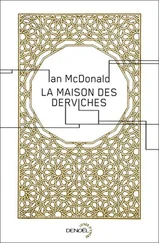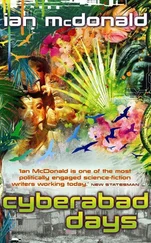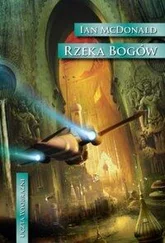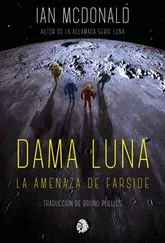Four hundred and fifty kilometres above Western Ecuador, Lisa Durnau runs through a herd of bobbets. They scatter from her, hiking up on their powerful legs and hoofing it, semaphore crests raised. The canopy forest echoes their warbling alarms. The young look up from their grazing, forelegs pawing at air in dread, then shrill and dive for their parents’ pouches. The waist-high sauro-marsupials peel away from Lisa in her running tights and top and shoes in two wings of fright, hatchlings trying desperately to stuff themselves headfirst into belly flaps. They’re one of Biome 161’s most successful species. The forests of Simulated Year Eight Million Before Present throb black with their herds. Alterre is running a hundred thousand years a Real World day, so by tomorrow they could be extinct; this high, humid cloud forest of umbrella-shaped trees desiccated by a climatic shift.
But in this ecological moment, this timeslice of what, in another age, another earth, will be northern Tanzania, today belongs to them.
The rush and dash of bobbets disturbs a group of tranter, reared up on their hind legs, sucking leaves from a trudeau tree. The big slow tree feeders drop to their longer forelegs and canter disjointedly away. Their internal armour plates move like machinery under willow-striped hides. Camouflage by William Morris, Lisa Durnau thinks. Botany by Rene Magritte. The trudeau trees are perfect hemispheres of leaves, regularly spaced across the plain like an exercise in statistical distribution. Some of the branches bear seed buds, penduluming on the breeze. They can scatter seed across a hundred-metre radius, like a riot-control flechette gun. That’s how they achieve their mathematical regularity. No trudeau will grow in the shade of another, but the forest canopy is a cornucopia of species.
Flickers of moving shadow between the trees; a flock of parasitic beckhams darts from the dead tranter in which they have injected their eggs. An ystavat stoops from its high glide path, darts and weaves and scoops up a laggard sauro-bat in the net of skin between its hind legs. A flip, a duck of the tearing beak, and the hunter climbs away again. Invulnerable, inviolable, Lisa Durnau runs on. No god is mortal in his own world and for the past three years she has been director, sustainer, and mediator of Alterre, the parallel Earth evolving in accelerated time on eleven and a half million Real-World computers.
Beckhams. Tranters. Trudeaus. Lisa Durnau loves the mischief of Alterre taxonomy. It’s the principles of astronomy applied to alternative biology; you find it lurking in your hard-drive, you name it. Mcconkeys and mastroiannis and ogunwes and hayakawas and novaks. Hammadis and cuestras and bjorks.
So very Lull.
She’s settled into her rhythm now. She could move like this forever. Some listen to music when they run. Some chat or read their mail or the news. Some have their aeai PAs brief them on the day. Lisa Durnau checks out what’s new across ten thousand biomes running on eleven and a half million computers participating in the biggest experiment in evolution. Her usual route is a loop around the University of Kansas campus, her marvellous and mysterious bestiary laid over the Lawrence traffic. There’s always something to surprise and delight, some new phone-directory name hanging off a fantastical creature that’s fought its way out of the silicon jungle. When the first arthrotects had appeared out of the insects by pure evolutionary leap on a Biome 158 host in Guadalajara, she had experienced that thrilled satisfaction you feel when a plot twist hits you that you didn’t expect. No one could have predicted the lopezs, but they had lain there, latent, in the rules. Then, two days ago the parasitogenic beckhams evolved from an elementary school in Lancashire and it hit her all over again. You never see it coming.
Then they fired her into space. She hadn’t seen that coming, either.
Two days ago she had been running her loop of the campus, past the honey stone faculty buildings, Alterre laid over Kansas summer. She turned by the student halls to run back to shower, shampoo, and office. In which a woman in a suit had been waiting as Lisa came in screwing water out of her ears with twists of tissue. She’d shown identifications and authorisations for responsibilities Lisa hadn’t known her nation ever needed and three hours later Lisa Durnau, Director of the Alterre Simulated Evolution project, was on a government hypersonic transport seventy-five thousand feet over central Arkansas.
The G-woman had told her luggage was strictly mass-limited but Lisa packed her running gear anyway. It felt like a friend. Down in Kennedy she took it out on to the space centre roads to unwind, to explore, to try to get some perspective on where she was and what her government was doing to her. With the sun setting across the lagoons, she ran past sentry rows of rockets, old boosters and missiles and heavy lift launchers. Glorious, perilous machines, now jammed like pikes into the earth, their purpose defeated, their shadows long as continents.
Forty-eight hours on, Lisa Durnau runs orbits of the centrifuge wheel of the ISS, wheeling over Southern Colombia. In her Alterre-sight she sees a krijcek castle rising in the distance above the trudeau tree cover. The krijcek are evolutionary arrivistes from Biome 163 in south-east coastal Africa. They’re a species of finger-sized dinos that have developed a hive culture, complete with sterile workers, breeders, egg laying queens, a complex social order based on skin colour, and herculean architecture. A new colony will work outwards from a small underground bunker, converting anything and everything organic to pulp, moulding it with dextrous tiny hands into soaring piers and towers and buttresses and vaulted egg chambers. Sometimes Lisa Durnau wishes she could override Lull’s naming policy. ‘Krijcek’ has a nice tone of lethality, but she would have loved to call them ‘gormenghasts’.
A chime in her auditory centre tells her her pulse rate has hit the required digits for the requisite amount of time. She has caught up with herself. Alterre’s un-reality has anchored her. She jogs to a stop, goes into her cool-down regime, and flicks out of Alterre. ISS’s centrifuge is a hundred-metre diameter ring, spun to give a quarter gravity. It rises sheer in front and behind her, she’s forever at the bottom of a spin-gravity well. Plant racks lend a gloss of green but nothing can conceal that this is aluminium, construction carbon, plastic, and nothing beyond. NASA doesn’t build its ships with windows. Outer space for Lisa Durnau has thus far been crawling from one sealed room to another.
Lisa stretches and flexes. Low grav puts different loads on new muscle groups. She slips off her runsoles, flexes her toes against the metal honeycomb. As well as an intensive NASA exercise regimen she takes calcium supplements. Lisa Durnau’s at the age a woman starts to think about her bones. ISS virgins have puffy faces and upper limbs as body fluids redistribute; sophomores a stretched, light, cat-look, but the long-termers eat their own bones. They spend most of their time up in the old core from which ISS has grown chaotically over its half-century in the sky. Few ever come down to dirty gravity, centrifugal or otherwise. Legend is they never can. Lisa Durnau wipes herself down with a moist towelette, seizes a wall rung, and hand-over-hands up the spoke towards the old core. She feels her weight dropping exponentially; she can grab a rung and swoop herself upwards two, five, ten metres. Lisa has a meeting with her G-woman up in the hub. A long-termer dives towards her, executing a neat midcourse somersault to point his feet downwards. He nods and he tumbles past Lisa. His flexibility makes her look like a walrus, but the nod encourages her. It is as warm a welcome as ISS has offered. Fifty people is small enough for first names, big enough for politics. Just like the faculty, then. Lisa Durnau loves the physicality of space but she does wish the budget had stretched to windows.
Читать дальше












